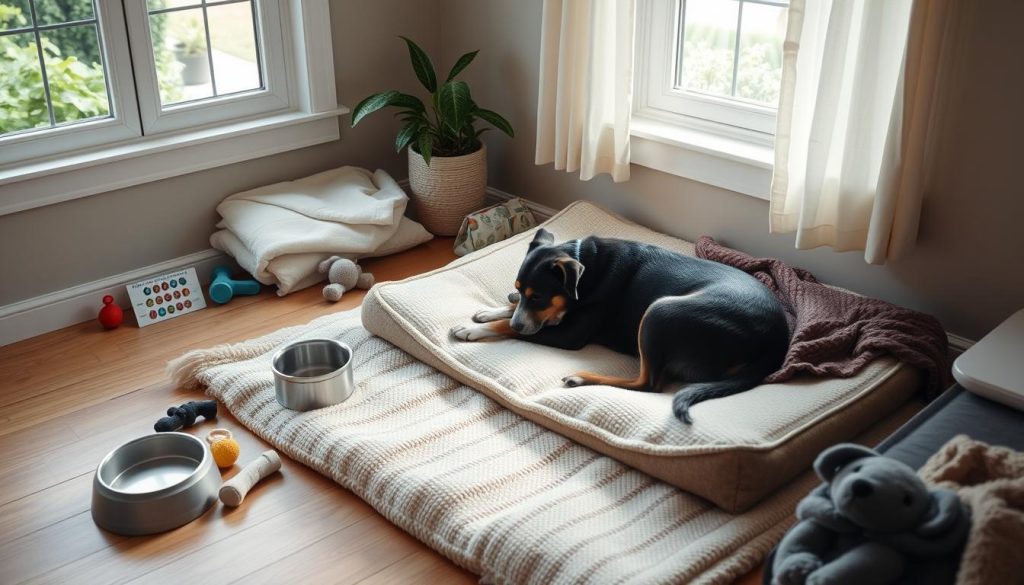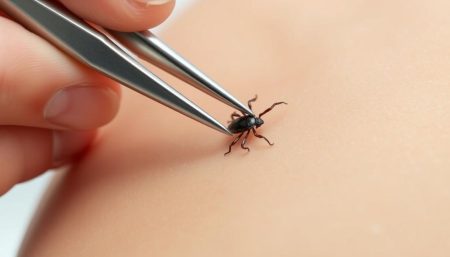When a dog gets a knee injury, TPLO surgery is often the answer. This surgery, called Tibial Plateau Leveling Osteotomy, is a top choice for fixing canine cruciate ligament problems. Our guide explores the world of dog knee surgery, giving pet owners a detailed look at the TPLO journey.
We’ll cover everything from the surgery itself to the recovery phase. Whether your dog is having TPLO surgery or you’re just learning, this guide aims to help. It’s packed with information to ensure your dog gets the best care and recovers well.
Understanding TPLO Surgery for Dogs
TPLO surgery is a new way to help dogs with cruciate ligament injuries. It’s a big change in how vets treat these problems in our furry friends.
What is Tibial Plateau Leveling Osteotomy
Tibial plateau leveling osteotomy, or TPLO, is a surgery for dogs with knee injuries. It cuts and rotates the tibia’s top to change the joint’s angle. This makes the damaged ligament unnecessary.
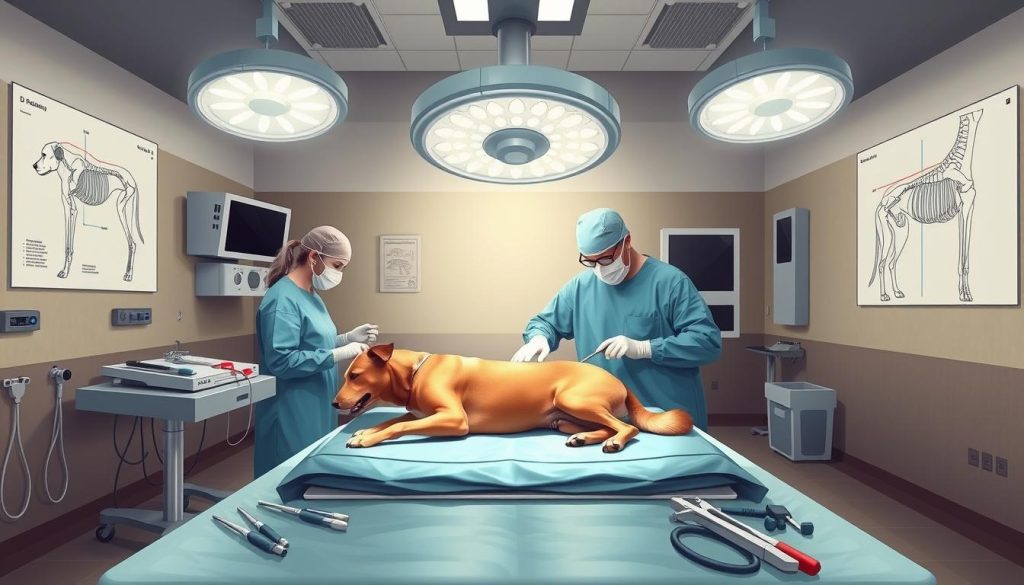
Common Reasons for TPLO Surgery
The main reason for dog ccl surgery is a torn or damaged cruciate ligament. This can happen from sudden trauma or wear and tear over time. Big dogs and active pets are more likely to get these injuries, needing surgery.
Benefits of TPLO Over Traditional Procedures
TPLO has many benefits over old treatments for dog knee injuries. It leads to quicker healing, better joint stability, and works well for all dog sizes. It’s also very successful, making it a top choice for vets.
- Quicker return to normal activities
- Reduced risk of arthritis development
- Suitable for both small and large breed dogs
- Long-lasting results
TPLO surgery changes the knee’s mechanics for a lasting fix. It helps dogs move better and live better lives.
Signs Your Dog Needs Cruciate Ligament Surgery
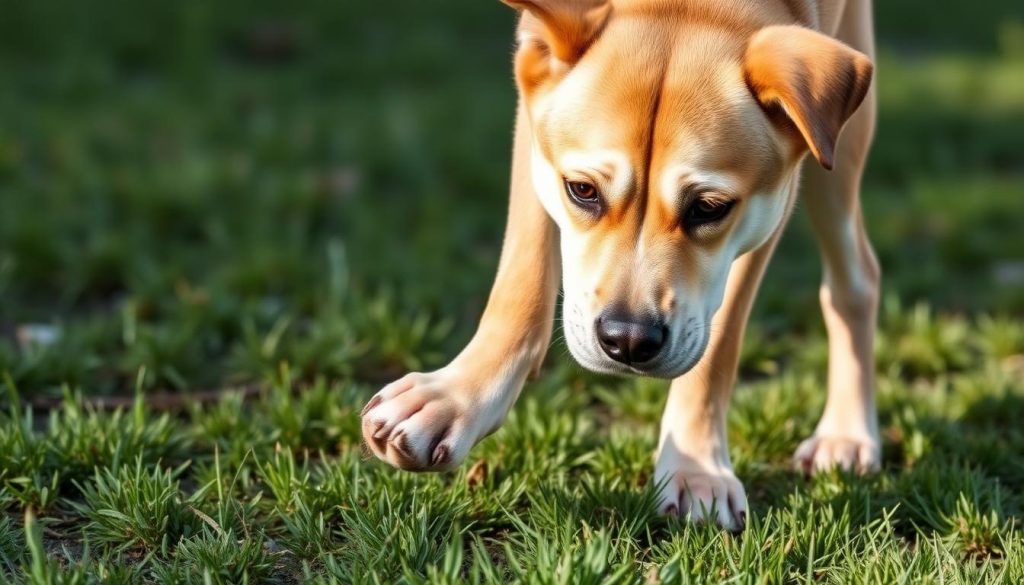
It’s important to know the signs of a dog cruciate ligament injury. Pet owners should watch for changes in their dog’s behavior and movement. Limping is often the first sign, seen after exercise or when getting up.
Dogs with cruciate ligament issues may not want to put weight on the affected leg. They might have trouble standing or sitting. Climbing stairs or jumping onto furniture becomes hard, and they might avoid these activities.
Physical changes can also show a need for canine knee surgery. Look for:
- Swelling around the knee joint
- Muscle atrophy in the affected leg
- Unusual sitting posture (leg extended outward)
- Audible clicking sounds from the knee area
If you see these signs, see a vet right away. They will do a full check-up and might suggest X-rays or MRI scans. Early detection can lead to better recovery and might avoid surgery.
“Catching a cruciate ligament tear early can make a significant difference in your dog’s recovery process and long-term mobility.”
Not all dogs with cruciate ligament injuries need surgery. Your vet will look at your dog’s size, activity level, and health. They will choose the best treatment for your dog.
Pre-Surgery Preparation and Considerations
Getting ready for pet orthopedic surgery is a big task. Your dog’s comfort and safety are top priorities. Let’s look at the key steps to prepare for your dog’s TPLO procedure.
Required Medical Tests
Your vet will run several tests before surgery. These include:
- Blood work to check organ function
- X-rays of the affected leg
- Physical exam to assess overall health
Preparing Your Home
Make a safe space for your dog to recover. Remove slippery rugs and block stairs. Set up a comfy bed in a quiet spot. This helps prevent accidents and aids in healing after the TPLO surgery.

Essential Recovery Supplies
Get these items ready before surgery:
- Protective cone or inflatable collar
- Non-slip mats for traction
- Supportive harness for mobility
- Raised food and water bowls
- Toys for mental stimulation
By preparing well, you ensure a smoother recovery. Your dog will thank you for the thoughtful arrangements as they heal from their TPLO procedure.
The TPLO Surgical Procedure Explained
TPLO surgery for dogs is a precise and effective procedure for canine ACL repair. This operation typically takes about 2-3 hours and involves several key steps.
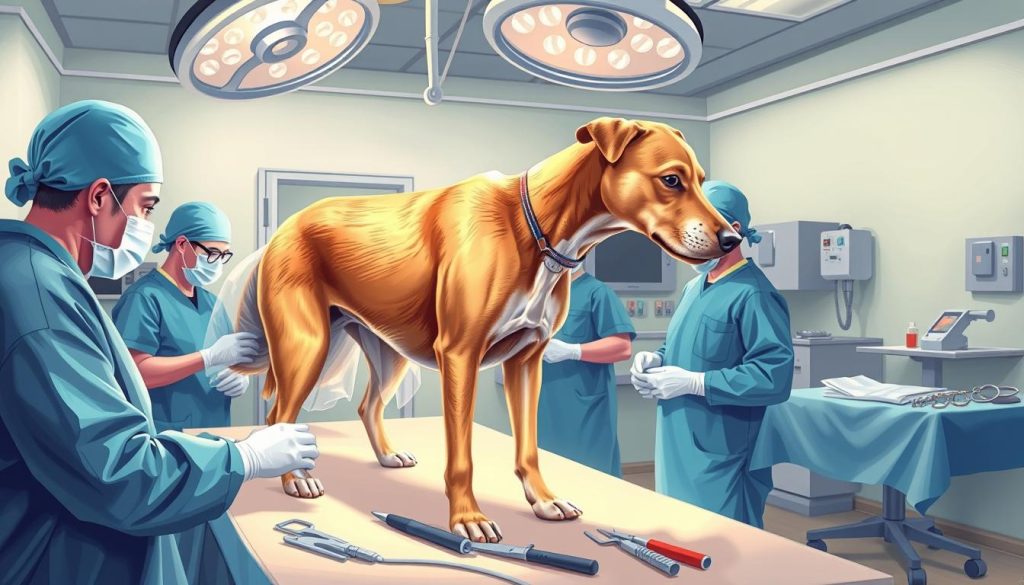
The process starts with the veterinarian making a careful incision on the inside of the dog’s knee. They expose the joint and examine the damaged cruciate ligament. Next, they remove any torn pieces of the ligament and address any meniscus injuries.
A critical part of the TPLO procedure is cutting and rotating the tibial plateau. This step changes the angle of the knee joint, eliminating the need for the cruciate ligament. The surgeon then secures the bone in its new position using a specialized TPLO plate and screws.
“TPLO surgery fundamentally alters the biomechanics of the knee, providing long-term stability for active dogs.”
Throughout the operation, the veterinary team closely monitors the dog’s vital signs. They adjust anesthesia levels as needed to ensure the pet’s comfort and safety. After closing the incision, they apply a sterile bandage to protect the surgical site.
| TPLO Surgery Step | Purpose |
|---|---|
| Joint Examination | Assess ligament and meniscus damage |
| Tibial Cut | Prepare for angle adjustment |
| Bone Rotation | Change knee joint mechanics |
| Plate Fixation | Stabilize new bone position |
Understanding the TPLO procedure helps dog owners appreciate the complexity of this canine ACL repair technique. It highlights why proper post-operative care is key for a successful recovery.
Immediate Post-Operative Care
After dog knee surgery, the first 24 hours are key for a smooth recovery. Pet orthopedics specialists stress the importance of close monitoring and proper care. This ensures the best outcomes for your furry friend.
First 24 Hours After Surgery
Your dog needs constant supervision after waking from anesthesia. Keep them warm and comfortable in a quiet space. Limit movement to prevent strain on the surgical site.
Offer small amounts of water, but avoid food unless your vet says it’s okay.
Pain Management Protocol
Effective pain control is vital after dog knee surgery. Your vet will create a pain management plan for your pet. This may include:
- Oral medications
- Anti-inflammatory drugs
- Local anesthetics
Follow dosage instructions carefully to keep your pet comfortable without overdoing it.
Monitoring Surgical Site
Regularly check the incision area for signs of infection or complications. Look for:
- Excessive swelling
- Discharge
- Redness
- Foul odor
Contact your pet orthopedics specialist immediately if you notice any concerning changes.

| Time | Action |
|---|---|
| Every 2 hours | Check incision site |
| Every 4-6 hours | Offer water |
| As prescribed | Administer pain medication |
| Once daily | Record temperature |
By following these guidelines, you’ll give your dog the best chance for a successful recovery from knee surgery.
Week-by-Week Recovery Timeline
Recovery from tplo surgery for dogs takes about 16 weeks. Knowing the timeline helps owners care for their pets well during this time.
The first two weeks are very important. Dogs need to rest a lot and move very little. They should have short, leashed potty breaks. It’s also key to manage their pain and care for their incision.
By weeks 3-4, dogs can start moving a bit more. They can do gentle exercises with vet guidance. SurgiPet suggests starting with 5-minute walks twice a day.
Weeks 5-8 are when dogs can do more. They can walk longer and even play indoors under watch. X-rays are used to check if the bones are healing right.
The last phase, weeks 9-16, is about getting stronger and more active. Dogs can do more energetic activities. By week 16, they should be fully recovered.
| Recovery Phase | Activities Allowed | Veterinary Check-ups |
|---|---|---|
| Weeks 1-2 | Short leashed potty breaks | Post-op follow-up |
| Weeks 3-4 | 5-minute leash walks twice daily | Incision check |
| Weeks 5-8 | Extended walks, supervised indoor play | X-rays for bone healing |
| Weeks 9-16 | Increased activity, strength building | Final recovery assessment |
Keep in mind, every dog recovers differently. Always listen to your vet’s advice for the best care after tplo surgery.
Physical Therapy and Rehabilitation Exercises
Physical therapy is vital for dogs after knee surgery. A good rehab plan helps them get strong and move well again. Experts in pet orthopedics create special exercises for each healing stage.
Early Stage Exercises
In the first weeks after surgery, it’s important to move gently. Exercises that help keep joints flexible are key. Short walks on a leash help the affected leg bear weight.
These early steps are the start of a successful recovery.
Progressive Movement Techniques
As healing goes on, exercises get tougher. Balance exercises on wobbly surfaces boost balance. Underwater treadmills offer a low-impact way to get a workout.
These methods help build strength without hurting the surgery area too much.
Advanced Rehabilitation Methods
Later, the focus is on building muscle and endurance. Agility drills, like weaving through poles, improve coordination. Incline walks strengthen the hind legs.
These advanced steps aim to get the dog fully functional again and prevent future injuries.
Throughout rehab, vets must keep a close eye on progress. Regular check-ups make sure the exercises are right for the dog. A tailored plan, using different techniques, helps dogs recover best from knee surgery.
Managing Pain and Complications
After dog knee surgery, it’s key to manage pain and watch for complications. Pet orthopedic surgery is hard on our pets. So, we must be careful and act fast.
- Prescribed medications
- Cold therapy packs
- Gentle massage
- Acupuncture (in some cases)
Look out for signs like swelling, redness, or discharge at the surgery site. If you see these, call your vet right away.
“Early intervention is key in addressing post-operative complications and ensuring the best outcome for your pet.”
Some common problems after pet orthopedic surgery include:
| Complication | Signs | Action |
|---|---|---|
| Infection | Fever, swelling, discharge | Seek immediate vet care |
| Implant issues | Limping, pain, swelling | X-ray and vet consultation |
| Delayed healing | Prolonged lameness | Follow-up with surgeon |
By being informed and attentive, you can help your dog feel better. This way, you can quickly handle any issues that come up after knee surgery.
Nutrition and Diet During Recovery
Proper nutrition is key for dogs after ACL repair. A balanced diet helps with healing and keeps your pet at a healthy weight. Let’s look at what foods can help your pet recover from dog ortho surgery.
Recommended Food Options
Choose foods that are high in protein and easy to digest. Lean meats like chicken or fish are great. Add foods rich in vitamins C and E to help with healing. Sweet potatoes and carrots are good for nutrients and fiber.
Supplements for Healing
Some supplements can help with recovery. Omega-3 fatty acids reduce inflammation and support joints. Glucosamine and chondroitin help repair cartilage. Always talk to your vet before adding supplements to your dog’s diet.
Weight Management Tips
Keeping your dog at a healthy weight is important during recovery. Too much weight can strain healing joints. Watch your dog’s calorie intake and adjust food portions as needed. Use a measuring cup for accurate feeding.
Avoid giving your dog table scraps and high-calorie treats. Regular weigh-ins help track your dog’s progress. This ensures they stay at an ideal weight during the healing process.
| Food Type | Benefits | Examples |
|---|---|---|
| Lean Proteins | Tissue repair | Chicken, Fish |
| Vegetables | Vitamins and Fiber | Sweet Potatoes, Carrots |
| Supplements | Joint Health | Omega-3, Glucosamine |
Activity Restrictions and Exercise Guidelines
After TPLO surgery for dogs, it’s key to follow strict activity rules for a smooth recovery. Dogs with cruciate ligament injuries need a special exercise plan. This helps them heal and regain strength.
In the first two weeks after surgery, keep your dog’s movements short. Use a leash for potty breaks. Start with 5-minute walks three times a day. By week six, most dogs can handle 15-20 minute walks.
Avoid these activities during recovery:
- Running or jogging
- Jumping on furniture
- Climbing stairs
- Playing with other dogs
- Swimming or bathing
To prevent overexertion, use a supportive harness. Keep your dog in a confined space when unsupervised. Gentle physical therapy exercises, as your vet prescribes, can help rebuild muscle strength and improve joint flexibility.
Remember, each dog’s recovery from TPLO surgery is unique. Always talk to your vet before changing your pet’s exercise routine. With patience and proper care, most dogs return to normal activity levels within 3-4 months post-surgery.
Long-term Care and Maintenance
After your dog’s TPLO surgery, long-term care is key for joint health and injury prevention. Experts in pet orthopedics suggest a balanced approach for your dog’s well-being after recovery.
Ongoing Exercise Requirements
Regular exercise is essential for your dog’s health after knee surgery. Start with short walks and gradually increase the time as your vet advises. Swimming is a low-impact exercise that’s gentle on joints. Always remember to keep it moderate to avoid overdoing it.
Prevention of Future Injuries
Keeping your dog at a healthy weight is important for joint health. Feed a balanced diet and watch portion sizes. Supplements with glucosamine and chondroitin can help cartilage health. Regular vet check-ups are key to monitor your dog’s health and catch any issues early.
- Keep walks on even surfaces to reduce the risk of slips or falls
- Avoid high-impact activities like jumping or rough play
- Use ramps or steps for getting in and out of cars or onto furniture
- Consider physical therapy sessions to maintain muscle strength and flexibility
By following these guidelines, you’ll help your dog enjoy a good quality of life after TPLO surgery. Remember, every dog is different. Always talk to your vet for specific advice on long-term care after dog knee surgery.
Success Rates and Expected Outcomes
Tibial plateau leveling osteotomy (TPLO) is a common surgery for dogs with knee problems. Many dog owners are curious about its success and long-term effects. Let’s look into the success rates and what you can expect after your dog has this surgery.
TPLO has high success rates. Research shows that over 90% of dogs can move freely again and feel less pain after the surgery. Most pets get back to their usual activities in 3-4 months after the surgery.
Several factors can affect success:
- Proper post-operative care
- Adherence to rehabilitation exercises
- Weight management
- Age and overall health of the dog
Many vets choose TPLO over older methods because of its good results. Dogs usually have better walking, more stability, and less lameness after the surgery.
“My Golden Retriever had TPLO surgery last year. Within six months, she was back to chasing balls and swimming like nothing ever happened!” – Sarah, dog owner
While results can vary, most dogs get lasting benefits from TPLO. This surgery is a hopeful solution for dogs with cruciate ligament injuries. It helps them get back to their active lives.
Cost Considerations and Insurance Coverage
Pet orthopedic surgery, like TPLO for dogs, can be expensive. The cost of TPLO surgery varies a lot. This depends on where you live, the vet clinic, and how complex the case is.
On average, TPLO surgery costs between $3,500 and $6,000 per knee. This price includes tests before surgery, the surgery itself, and care right after. Some vets offer deals that include all these services.
| Cost Component | Estimated Range |
|---|---|
| Initial Consultation | $100 – $200 |
| Pre-operative Tests | $200 – $400 |
| TPLO Surgery | $2,500 – $4,500 |
| Post-operative Care | $500 – $1,000 |
| Medications | $200 – $400 |
Pet insurance can help with these costs. Many policies cover orthopedic surgeries. But, it’s important to know what your policy covers and any waiting periods. Some insurers have a 6-12 month wait for cruciate ligament surgeries.
If you don’t have pet insurance, talk to your vet about payment plans. Some clinics offer Care Credit for vet bills. Don’t forget to include costs for physical therapy and follow-up visits in your budget for your dog’s TPLO surgery.
Choosing a Qualified Veterinary Surgeon
Finding the right vet for your dog’s TPLO surgery is key. Look for a vet who is board-certified in pet orthopedics. They have the training needed for complex surgeries like TPLO.
Check the vet’s experience and success with TPLO surgeries. Make sure they have the latest technology and equipment. Also, ask about their care plans after surgery. Proper care is essential for recovery.
Ask about pain management and rehabilitation during your visit. A good vet will explain the surgery and answer your questions. You should feel at ease with the vet and their team. This comfort is important for your dog’s surgery and recovery.
Choosing a skilled vet for TPLO surgery is an investment in your dog’s health. Take your time to research and talk to several vets. Your dog deserves the best care for this important surgery.
FAQ
Q: What is TPLO surgery for dogs?
A: TPLO (Tibial Plateau Leveling Osteotomy) surgery is a procedure for dogs. It treats injuries to the knee ligament. The surgery changes the knee’s mechanics, making it work without the ligament.
Q: How long does recovery from TPLO surgery take?
A: Recovery from TPLO surgery takes about 12-16 weeks. But, it can take up to 6 months to fully heal. The time needed varies based on the dog’s health and size.
Q: What are the signs that a dog needs cruciate ligament surgery?
A: Signs a dog needs surgery include limping and trouble standing. They might also avoid jumping or climbing stairs. Swelling in the knee is another sign. A vet can confirm this with tests.
Q: How should I prepare my home for my dog’s TPLO surgery recovery?
A: Make a safe space for your dog with a comfy bed. Make sure the floor is non-slip. Remove obstacles and use gates to keep them safe. Get protective cones, mats, and harnesses ready.
Q: What does the TPLO surgical procedure involve?
A: The surgery starts with an incision in the knee. Then, the tibial plateau is cut and rotated. It’s fixed with a plate and screws. The whole process takes 2-3 hours under anesthesia.
Q: How is pain managed after TPLO surgery?
A: Pain meds, anti-inflammatories, and sometimes local anesthetics are used. Cold therapy and rest are also key. This helps manage pain after surgery.
Q: What physical therapy exercises are recommended after TPLO surgery?
A: Start with gentle exercises and then move to leash walks and underwater therapy. Always follow your vet’s advice on exercises.
Q: What complications can occur after TPLO surgery?
A: Complications include infection and implant issues. Delayed healing and rare fractures can also happen. Watch the surgical site and report any problems to your vet.
Q: How should I adjust my dog’s diet during TPLO recovery?
A: Feed a balanced diet that supports healing. Omega-3s and glucosamine can help. Talk to your vet about the best diet for your dog.
Q: What are the long-term care requirements after TPLO surgery?
A: Keep your dog’s weight healthy and exercise them gently. Joint supplements might be needed. Regular vet visits and imaging are important for monitoring.
Q: What is the success rate of TPLO surgery?
A: TPLO surgery is very successful, with 90-95% of dogs improving. Success depends on post-op care and rehabilitation.
Q: How much does TPLO surgery typically cost?
A: Costs vary by location and vet. It’s usually between ,500 and ,000. This includes tests, surgery, and care after.
Q: How do I choose a qualified veterinary surgeon for TPLO surgery?
A: Choose a vet with TPLO experience. Look at their success rate, facility, and care plans. Ask for references or get a second opinion.












